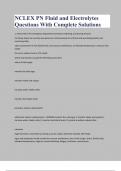NCLEX PN Fluid and Electrolytes
Questions With Complete Solutions
.a client enters the emergency department confused, twitching, and having seizures.
his family states he recently was placed on corticosteriods for arthritis and was feeling better and
exercising daily.
upon assessment, he has flushed skin, dry mucous membranes, an elevated temperature, and poor skin
turgor.
his serum sodium level is 172 mEq/L.
which interventions would the HCP likely prescribe?
select all that apply.
monitor the vital signs
monitor intake and output
increase water intake orally
monitor electrolyte levels
provide a sodium-reduced diet
administer sodium replacements - ANSWER-monitor the vital signs // monitor intake and output //
increase water intake orally // monitor electrolyte levels // provide a sodium-reduced diet
rationale
hypernatremia is described as having a serum sodium level that exceeds 145 mEq/L.
signs and symptoms would include dry mucous membranes, loss of skin turgor, thirst, flushed skin,
elevated temperature, oliguria, muscle twitching, fatigue, confusion, and seizures.
,interventions include monitoring fluid balance, monitoring vital signs, reducing dietary intake of sodium,
monitoring electrolyte levels, and increasing oral intake of water.
sodium replacement therapy would not be prescribed for a client with hypernatremia.
.a client enters the emergency department confused, twitching, and having seizures.
his family states he recently was placed on corticosteroids for arthritis and was feeling better and
exercising daily.
on data collection, he has flushed skin, dry mucous membranes, an elevated temperature, and poor skin
turgor.
his serum sodium level is 172 mEq/L
which interventions would the HCP likely prescribe?
select all that apply
monitor vital signs
monitor electrolyte levels
increase water intake orally
monitor intake and output
maintain sodium-reduced diet
administer sodium replacements - ANSWER-monitor vital signs // monitor electrolyte levels // increase
water intake orally // monitor intake and output // maintain sodium-reduced diet
rationale
hypernatremia is described as having a serum sodium level that exceeds 145 mEq/L
signs and symptoms would include dry mucous membranes, loss of skin turgor, thirst, flushed skin,
elevated temperature, oliguria, muscle twitching, fatigue, confusion, and seizures.
,interventions include monitoring fluid balance, monitoring vital signs, reducing dietary intake of sodium,
monitoring electrolyte levels, and increasing oral intake of water.
sodium replacement therapy would not be prescribed for a client with hypernatremia.
.a client has a serum sodium level of 129 mEq/L because of hypervolemia.
the nurse consults with the HCP to determine whether which measure should be instituted?
a) restricting fluid intake
b) providing a 2-g sodium diet
c) providing a 4-g sodium diet
d) administering IV hypertonic saline - ANSWER-a) restricting fluid intake
rationale
hyponatremia is defined as a serum sodium level of less than 135 mEq/L
when it is caused by hypervolemia, it may be treated with fluid restriction.
the low serum sodium value is a result of hemodilution.
IV hypertonic saline (3%) is reserved for hyponatremia when the serum sodium level is lower than 125
mEq/L
a 4-g sodium diet is a no-added-salt diet; a 2-g sodium diet does not raise the serum sodium level
.a client has been admitted to the hospital with a diagnosis of severe nausea and vomiting.
the client has an indwelling IV catheter.
the client's morning lab results show a serum blood sodium level of 130 mEq/L and a serum blood
chloride level of 92 mEq/L
which IV fluids will provide free water, sodium, and chloride to the client?
select all that apply
, ringers solution
0.9% NaCl in water solution
0.45% NaCl in water solution
Dextrose 5% in 0.225% NaCl solution
Dextrose 5% in lactated ringers solution - ANSWER-0.45% NaCl in water solution // dextrose 5% in
0.225% NaCl solution
rationale
the IV fluid 0.45% NaCl in water solution provides free water in addtion to Na+ and Cl-
dextrose 5% in 0.225% NaCl solution provides Na+ Cl- and free water.
Ringers solution is similar in composition to plasma except that it has excess Cl- no Mg2+ and no HCO3-
it does not provide free water or calories.
the IV fluid 0.9% NaCl in water solution does not provide free water, calories, or other electrolytes.
5% Dextrose in Lactated ringers (Hartmann's) solution is similar in composition to normal plasma except
it does not contain Mg2+ and it does not provide free water.
.a client is 3 days postoperative from gastric surgery and still has a nasogastric tube in place.
the client is at risk to develop which electrolyte imbalances?
select all that apply
hypokalemia
hyperkalemia
hyponatremia




